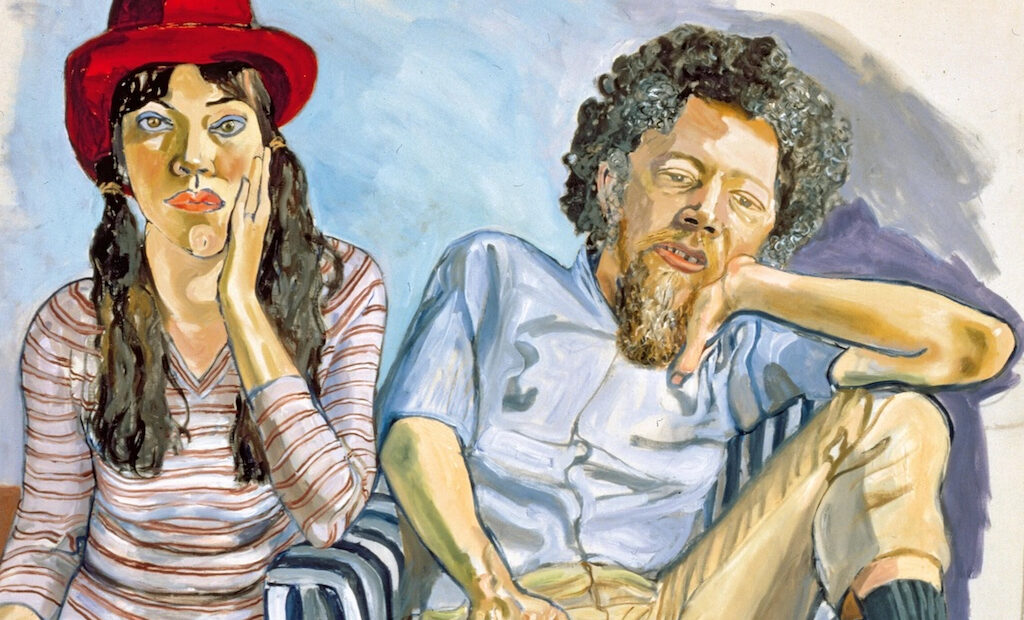Alice Neel: Hot off the Griddle at Barbican Art Gallery

Completed when the artist was 80, Alice Neel’s self-portrait of 1980 finds the American casting an enquiring, unflinching eye upon her ageing body. The ruddiness of her cheeks suggests an enduring vitality at odds with her sagging form as she sits in her much-depicted blue-and-white striped chair, naked apart from her glasses. It offers a memorable beginning to the Barbican Art Gallery’s new retrospective of the predominantly New York-based Neel’s six-decade career.
Bringing together more than 70 of the artist’s portraits, along with archival photography and film, Alice Neel: Hot off the Griddle has been organised in collaboration with the Centre Pompidou, Paris. The show takes a chronological approach, fuelled by fresh research, and sees this spirited painter, largely neglected by the art world for decades of her life, capturing the shifting social and political context of 20th century America.
Alice Neel (1900-1984) was never one to bow to convention. Born in Colwyn, Pennsylvania, she would attend the Philadelphia School of Design in 1921 where she met the Cuban artist, Carlos Enriquez Gomez. Their 1925 marriage led to a period spent in Havana that ended with divorce in 1930, resulting in Neel suffering a breakdown. After recovering, she moved to Greenwich Village, the bohemian heart of New York, with her new lover, Kenneth Doolittle, who introduced her to members of the US Communist Party. She would join the party herself in 1935. During that decade, the appearance of her work changed dramatically. Neel painted street scenes highlighting the extreme poverty endured by many, as well as portrayals of workers on strike. She also immersed herself in the artistic community. One finds her depicting the village eccentric Joe Gould, whom she pokes fun at for his claims of virility by painting him with five penises. In another bawdy image, her lover John Rothschild appears urinating into a sink while Neel sits on a loo.
Then, in 1938 she made the decision to move to Spanish Harlem with the Puerto Rican musician José Santiago, which would have a pivotal role in the shaping of her artistic practice. Settling here for most of the 40s and 50s, the artist often painted her neighbours with notable compassion and empathy. In Black Spanish-American Family (1955), the mother’s world-weary expression contrasts with the youthful innocence of her two daughters. Another work shows Santiago’s brother stricken with tuberculosis. Describing herself as a “collector of souls”, Neel continued to paint figuratively, despite this being the heyday of Abstract Expressionism. The artist’s political affiliations also lead her to turn her distinctive expressionist style to portraits of leftwing intellectuals like Harold Cruse, and her one-time partner, the Communist film director, Sam Brody. Such radical work brought attention from the FBI. Her penetrating 1950 painting of Cruse (who would later become a significant figure in the civil rights movement) sees the deployment of strong outlines as the viewer notices the evolution of Neel’s mature work.
The two large downstairs galleries at the Barbican focus on Neel’s later period with figures markedly delineated in vigorously laid outlines in blue and black. One also finds Robert Frank and Alfred Leslie’s short 1959 film Pull My Daisy, narrated by Jack Kerouac and featuring (among others) Allen Ginsberg and the artist herself. By this stage Neel’s reputation was on the rise. Many of the portraits from the 60s and 70s are of individuals from a more affluent demographic than before. The gay artist couple, Geoffrey Hendricks and Brian Buczak, are depicted with a suggestively arranged fruit bowl. Elsewhere, Linda Nochlin, famed for her challenging 1971 essay, Why Have There Been No Great Women Artists?, sits beside her flame-haired daughter. Some ironic humour can be found in the critic and curator John Perreault posing for her in the nude, having apparently asked her to include her work in a show devoted to the nude. He becomes the subject of the gaze. Surely Neel’s best-known work, her haunting 1970 painting of a shirtless and vulnerable-looking Andy Warhol that exposes the scars from his near fatal shooting in 1968, also bears witness to both her steadfast refusal to flatter and the respect she accorded to her sitters.
In her final years, Alice Neel achieved a level of fame in her country, being given a major exhibition at the Whitney Museum of American Art in New York in 1974. She even made charmingly witty appearances on the Johnny Carson chat show. This absorbing retrospective is brought to a close with a documentary film by Nancy Baer that offers the opportunity to hear Neel herself discussing her life and art. The artist’s so-called “anarchic humanist figuration” and its ability to bring out the humanity in individuals, regardless of race, class or gender, promises to continue to enthral and inspire future generations of artists.
James White
Alice Neel: Hot off the Griddle is at Barbican Art Gallery from 16th February until 21st May 2023. For further information visit the exhibition’s website here.
























Facebook
Twitter
Instagram
YouTube
RSS